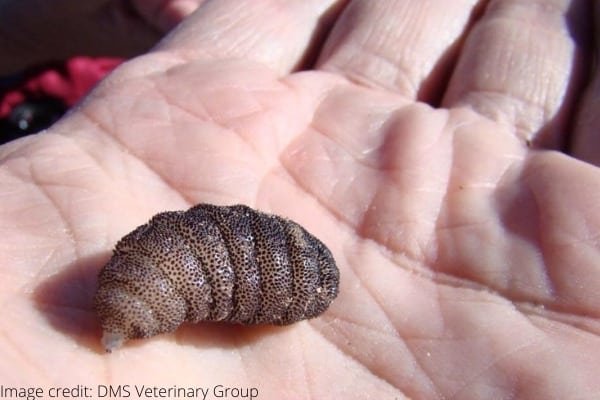
Now, you might be wondering how to spot these pesky intruders before they take over. Identifying wolf worm infestation in outdoor pets isn’t as daunting as it sounds, but it does require a keen eye and some basic knowledge. Let’s dive into the world of wolf worms, how to recognize them, and what to do if you think your pet is affected.
What Are Wolf Worms?
Wolf worms, scientifically known as Cuterebra, are the larvae of botflies. The adult botfly lays its eggs on the ground or on vegetation, and when a curious pet walks by, these larvae can attach themselves to their fur. They are particularly known to affect cats and dogs that spend a lot of time outdoors.
You’ll often find these larvae burrowing into the skin of your pet, where they can grow and develop. It’s a bit like hosting a tiny, unwelcome tenant in your pet’s body. While wolf worms aren’t typically life-threatening, they can cause discomfort and infection if not caught in time.
The size of these larvae can range from about one inch to sometimes even larger when fully matured. They can look like small, wriggling maggots, which can be quite alarming if you’re not prepared for it. Their presence can be a red flag that something’s not right with your fur baby.
Signs of Infestation
Identifying wolf worm infestation in outdoor pets requires a watchful eye. Here are the most common signs you should look for:
- Swelling or Lump: One of the first signs is a noticeable lump on your pet’s body. This can feel firm and might be warm to the touch.
- Hair Loss: Often, the area around the lump will show signs of hair loss, making it easier for you to spot.
- Discharge: You may notice an unusual discharge or fluid coming from the lump, which can indicate infection.
- Restlessness: Your pet might seem more restless or uncomfortable, as if they’re trying to scratch or bite at the area.
If you notice any of these signs, it’s time to take action. The sooner you address this issue, the better.
How Wolf Worms Affect Pets
So, what happens when a wolf worm gets cozy inside your pet? Well, it can lead to a range of health problems. When the larvae burrow into the skin, they can cause inflammation and irritation. This may result in a painful abscess that could even become infected. Here’s why you should pay attention:
– Pain and Discomfort: Your pet will likely experience pain where the larvae are located, leading to a lot of discomfort and potential behavioral changes.
– Infection Risks: If left untreated, the area can become infected. This could lead to more severe health issues that might require a vet’s attention.
– Systemic Effects: Although rare, the presence of the larvae can sometimes lead to more systemic effects, especially if the infestation is severe.
If your pet is showing signs of discomfort, it’s crucial to consult with your veterinarian. They can help determine if wolf worms are the cause and recommend the best course of action.
Prevention Tips
Preventing wolf worm infestation is much easier than dealing with an active case. Here are some strategies to keep your pets safe:
- Regular Check-ups: Schedule regular vet check-ups, especially during warmer months when these pests are more prevalent.
- Grooming: Regular grooming sessions help remove any potential larvae or eggs before they can attach to your pet’s skin.
- Avoid Tall Grass: Try to keep your pets away from tall grass or brush, where these botflies are likely to lay their eggs.
- Use Preventative Treatments: Consult your vet about parasite prevention products that can help keep these pests at bay.
By taking these precautions, you can significantly reduce the chances of your outdoor pet becoming a target for wolf worms.
Diagnosing Wolf Worm Infestation
If you suspect your pet has a wolf worm infestation, it’s essential to get a proper diagnosis. Your veterinarian will likely perform a physical examination, looking for the typical signs we’ve discussed. They might also:
– Use Imaging Techniques: Sometimes, they may use ultrasound or X-rays if they suspect there might be larvae in deeper tissues or organs.
– Take Samples: In some cases, taking a sample from the lump can help determine if there’s a wolf worm or if another issue is causing the problem.
Once diagnosed, your vet can recommend the best treatment plan tailored to your pet.
Treatment Options
Treating wolf worm infestations generally involves a few key steps:
1. Removal of Larvae: Your vet will likely need to remove the larvae from your pet’s body. This might involve a simple procedure, or more care may be needed for larger infestations.
2. Treatment for Infection: If there’s an infection, your vet may prescribe antibiotics or topical treatments to help heal the area and prevent further issues.
3. Pain Management: Depending on how much discomfort your pet is in, pain relief medication might also be necessary to ensure they’re comfortable during recovery.
Every pet is different, so treatment plans can vary. It’s best to follow your vet’s advice closely for the best outcome.
Identifying wolf worm infestation in outdoor pets is crucial for their health and well-being. By keeping an eye out for signs like lumps, hair loss, and discomfort, you can take swift action to help your furry friend.
Remember, prevention is your best defense. Regular vet check-ups, good grooming practices, and careful monitoring of your pet’s outdoor activities can go a long way. If you suspect an infestation, don’t hesitate to consult your vet. Keeping your pet happy and healthy is worth it!
